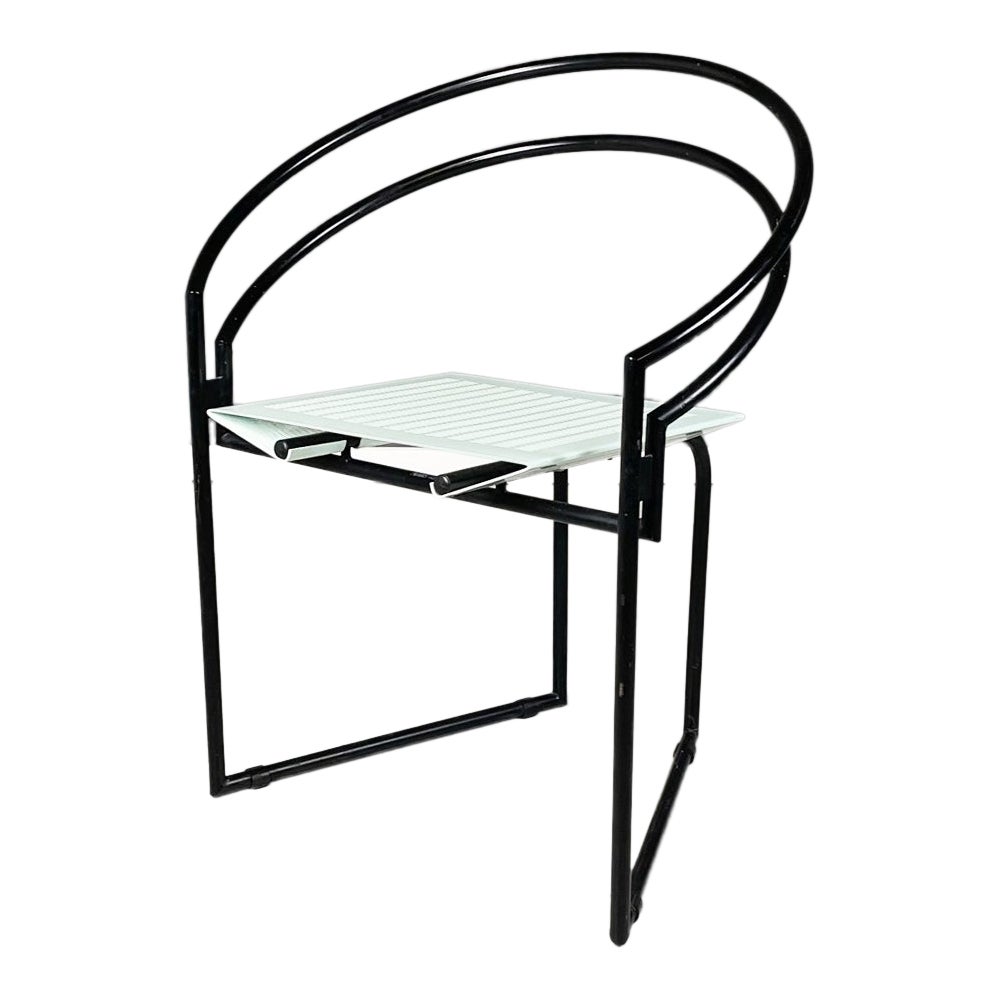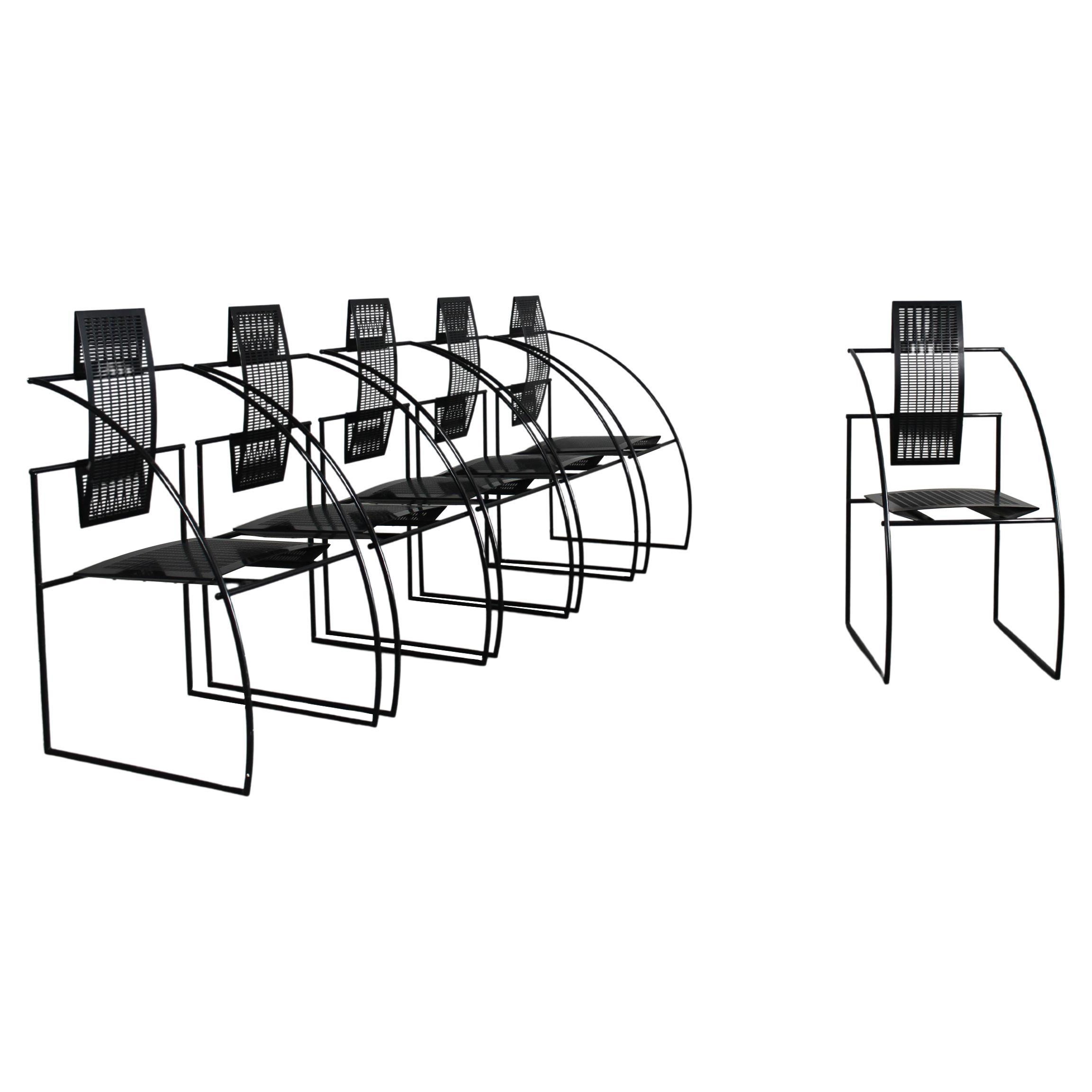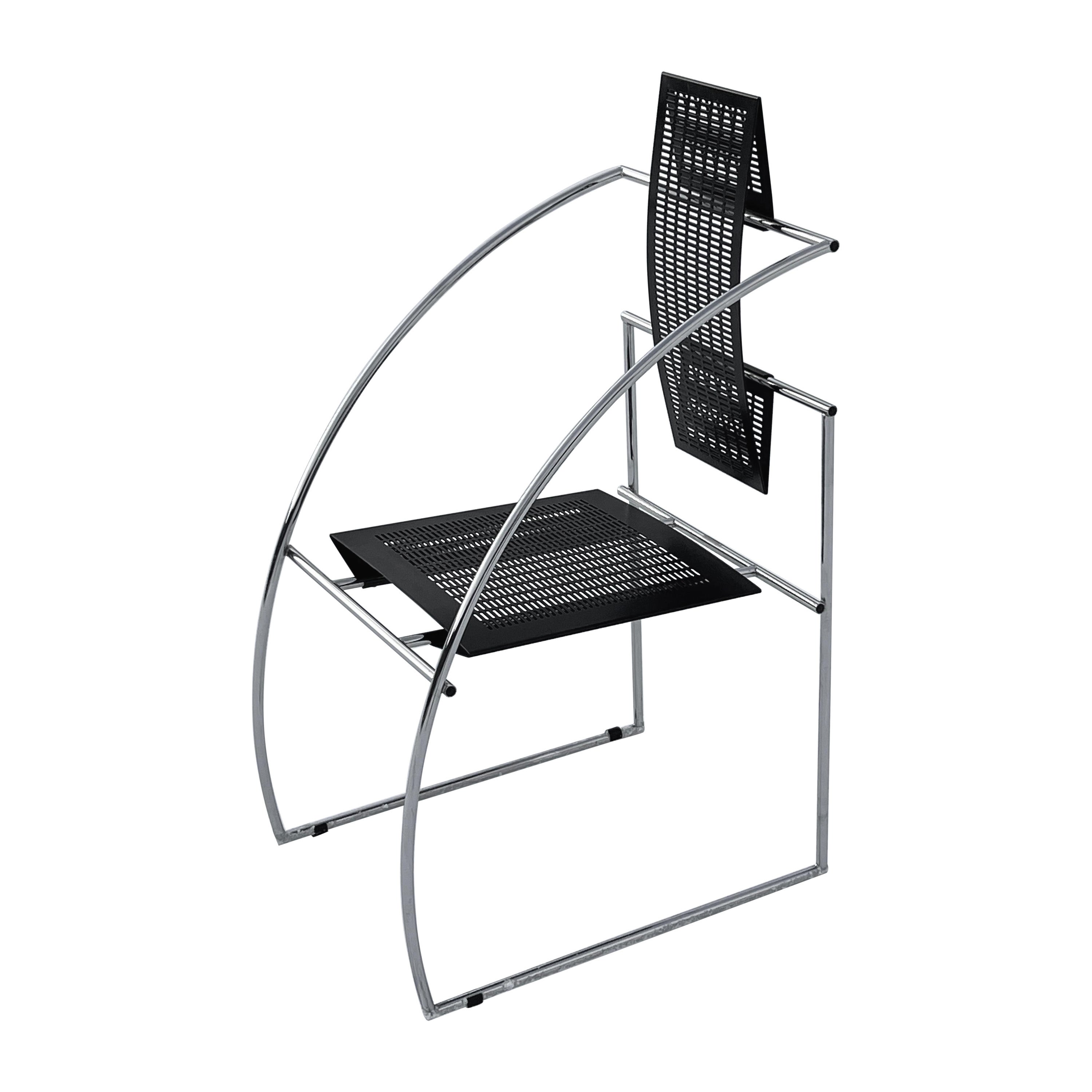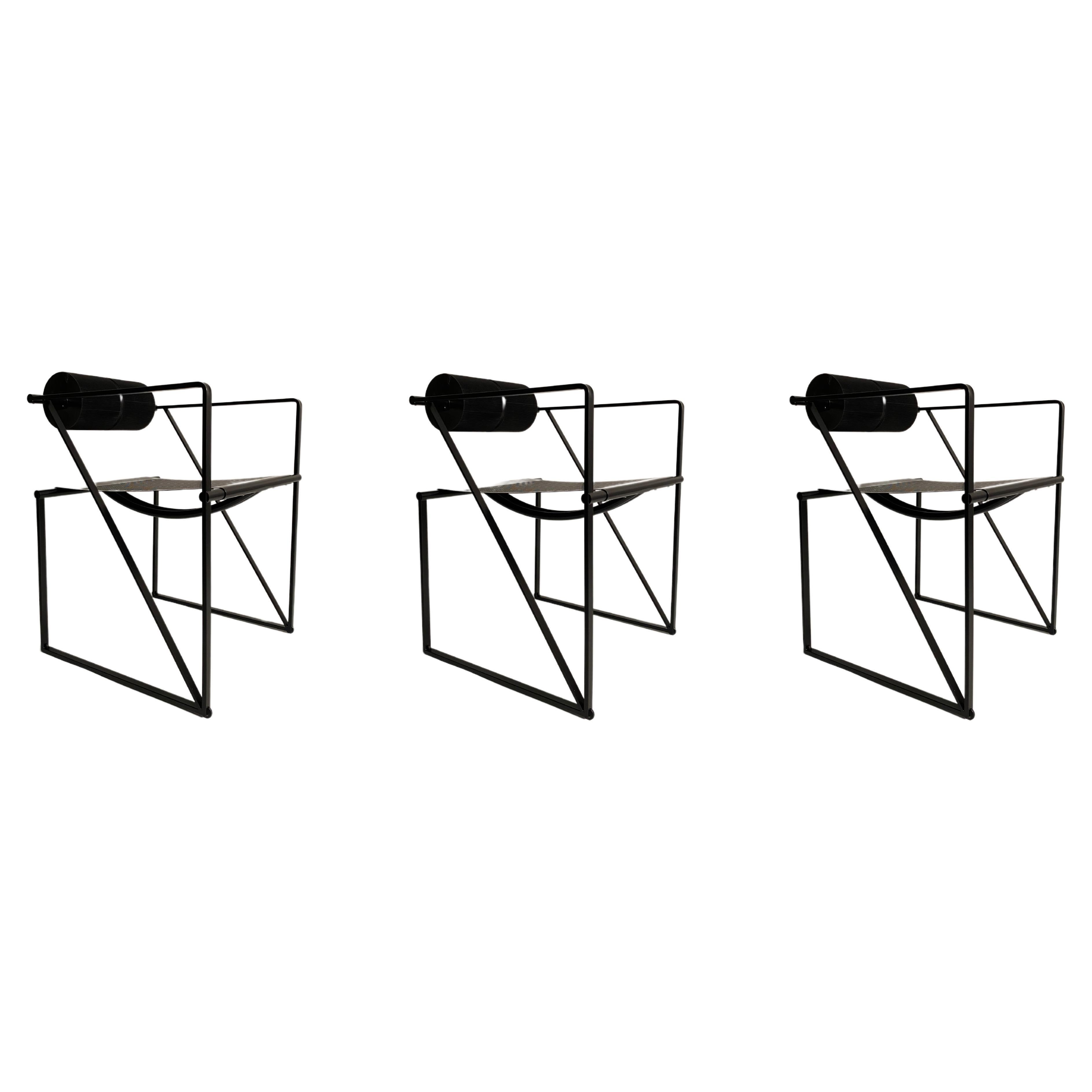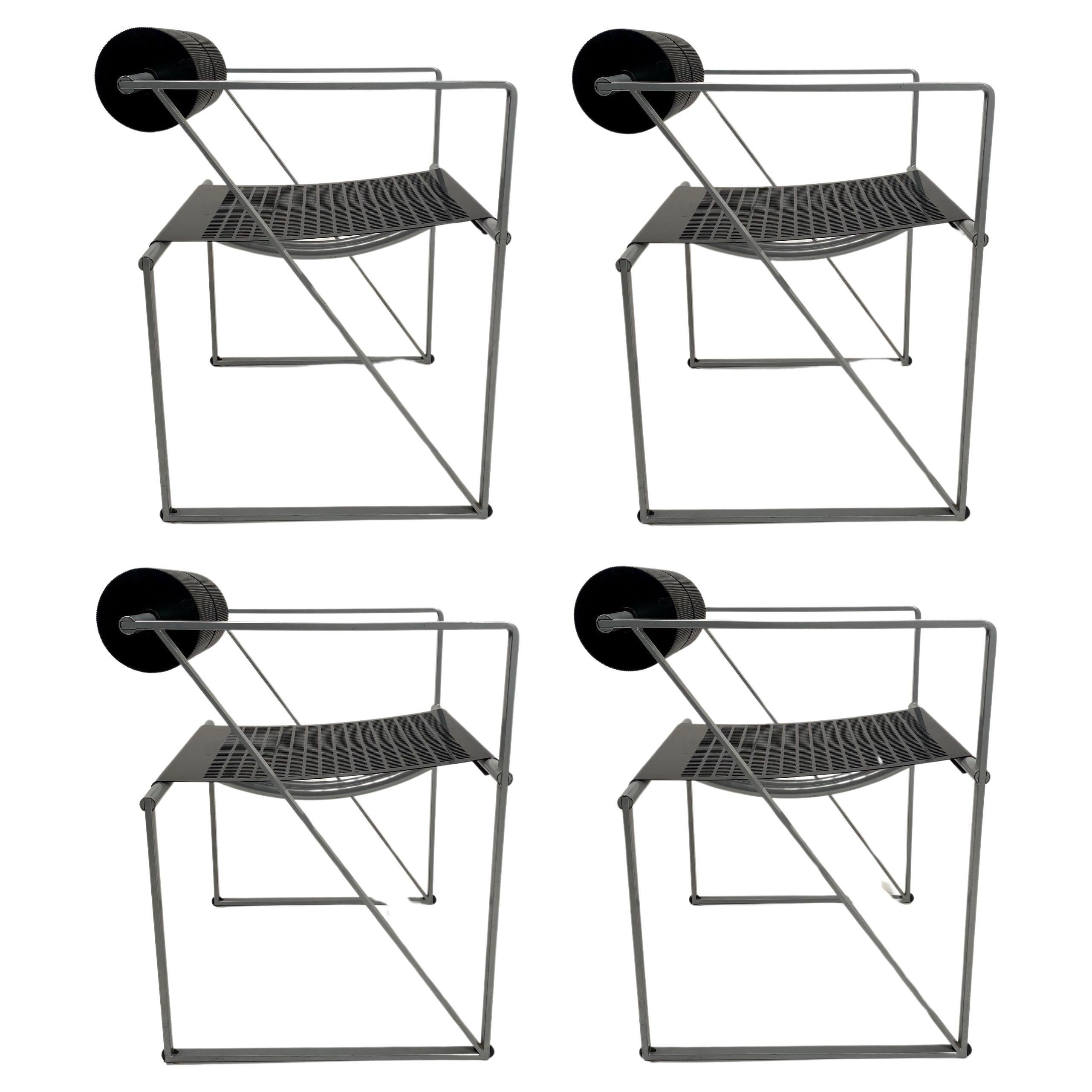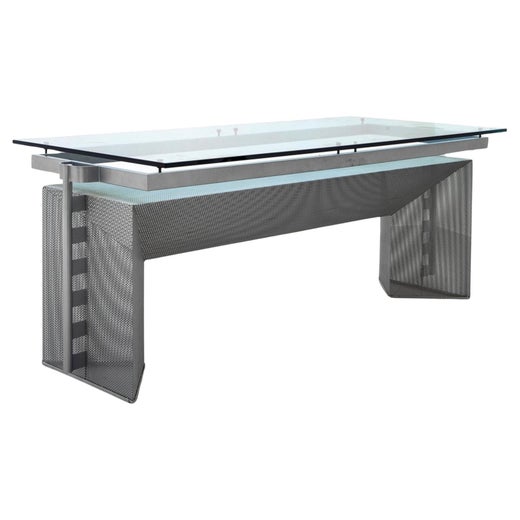Mario Botta Set of Six La Tonda Chairs in Black Lacquered Metal by Alias 1980s
About the Item
- Creator:Mario Botta (Designer),Alias (Manufacturer)
- Dimensions:Height: 29.93 in (76 cm)Width: 24.81 in (63 cm)Depth: 19.69 in (50 cm)
- Sold As:Set of 6
- Style:Modern (Of the Period)
- Materials and Techniques:
- Place of Origin:
- Period:1980-1989
- Date of Manufacture:1980s
- Condition:Minor losses.
- Seller Location:Montecatini Terme, IT
- Reference Number:1stDibs: LU5304239448422
Mario Botta
Swiss architect Mario Botta may be renowned for his impressive postmodern architecture projects such as the San Francisco Museum of Modern Art, but the chairs, lighting and other furniture he created reflect a mastery of geometrically rich forms and an elegant application of simple symmetry.
Born in Mendrisio, Switzerland, in 1943, Botta gained an interest in architecture at an early age. He apprenticed at the architectural firm Carloni and Camenisch and designed his first building — a two-family house at Morbis Superiore in Ticino — at age 16. During the early 1960s, Botta attended the Liceo Artistico in Milan and then studied at the University Institute of Architecture in Venice under art historian Giuseppe Mazzariol and influential Italian architect Carlo Scarpa.
While studying in Venice, Botta worked for Swiss-born French architect Le Corbusier — whose career spanned hundreds of architecture projects — and gained inspiration from Estonian-American architect Louis Kahn, who was known for his modern and brutalist architectural style. In 1969, Botta completed his studies and established his practice in Lugano, designing and building single-family homes.
Throughout the 1970s, Botta gained fame for his innovative, geometrical designs and deceptively simple forms, such as his first large-scale building project in 1977 — the Middle School in Morbio Inferiore, Switzerland. Botta later established himself as one of the masters of 1980s postmodern design in his architecture and his furniture. His postmodern ideas characterize the dining room tables and seating he designed for companies such as Alias, as well as his table lamps and floor lamps for Artemide.
Botta’s noteworthy architectural projects designed during the 1990s and 2000s include the Cymbalista Synagogue and Jewish Heritage Center in Tel Aviv, Israel; the Monastery of the Holy Apostles Saint Peter and Andrew in Lviv, Ukraine; and the Theater of Architecture in Mendrisio, in 2018.
On 1stDibs, discover a range of vintage Mario Botta lighting fixtures, seating, tables and decorative objects.
- ShippingRetrieving quote...Ships From: Borgo a Buggiano, Italy
- Return PolicyA return for this item may be initiated within 7 days of delivery.
- Mario Botta Set of Six 605 Quinta Chairs in Black Lacquered Steel by Alias 1980By Alias, Mario BottaLocated in Montecatini Terme, ITSet of six 605 Quinta chairs with a black steel rod frame seat and back in bent perforated sheet metal. Designed by Mario Botta for Alias in 1985 (This chair is no longer in production). The Quinta chair it's an architecture you can sit on, this design clearly shows the inspiration of iconic designer as Le Corbusier, Louis Kahn, and Carlo Scarpa, an exemplary of this iconic chair is also exhibited at the Museum of Modern Art. Mario Botta was born in 1943 in Mendrisio. After working as an apprentice draughtsman for the Lugano-based architect Tita Carloni, he moved first to Milan and then to Venice, where he enrolled at the department of Architecture at the IUAV. He completed his degree in 1969 with a thesis tutored by Carlo Scarpa – after having met Le Corbusier and Louis Kahn, who were later to be sources of inspiration – and returned to Switzerland to open his own professional firm, which at the time dealt mainly with detached family private homes. These included the villas in Riva San Vitale (1971-1973), Ligornetto (1975-1976) and Morbio Superiore (1982-1983), in which Botta treated the theme of the home as a refuge, which protects and reassures its inhabitants. These were buildings with a character that was ironic and, in a certain sense, monumental, obtained for example (in the case of Morbio) through rigorous symmetrical compositions and a particular use of raw concrete blocks set in a linear pattern and alternated with strips of silvered brick which, on the contrary, were set at 45 degrees. Partially dug into the hillside, the villa was also characterised by a theme which was particularly dear to Botta and which had already been explored in Riva San Vitale; the net distinction between solids and voids, the latter appearing to have been dug out of the building. Between 1980 and 1990, Botta associated with artists and intellectuals from all walks of life and took numerous long trips abroad. Together with Gabriele Basilico and Edoardo Sanguinetti, he published “La Casa Rotonda”, and he became friends with Max Huber, Nicki de Saint Phalle, Dante Isella, Harld Szeemann, Robert Frank and Alberto Flammer. In 1986, the MoMA in New York dedicated a solo exhibition to his work, and the Swiss architect received his first contracts for public buildings and from abroad, debuting with the Cultural Centre in Chambéry (1984-1987). In Japan, on a challenging triangular lot of only one hundred and sixty square metres, a space which remained from the opening of a new highway, Botta built a small building which, with its clarity and strength of image, attempted to stand out in the midst of the chaos that surrounded it, thanks to a thick masonry curtain raised on the main façade, in which slabs of grey marble are crossed with horizontal fissures which erode the angles and cancel the perception of the number of floors which make up the museum. The church of Mongo, on the other hand, was the first step in a long series of places of worship, including designs for the churches of Pordenone (1987-1992) and Sartiana (1987-1995), for the cathedral of Evry (1988-1995), for the basilica of Santa Maria degli Angeli on Mont Tamaro (1990-1996, for the Giovanni XXII church in Seriate (1994-2000) and for the Cymbalista synagogue in Tel Aviv (1996-1998). In each of these, light plays a predominant role as a prime generator of space and a measure for the definition of time that passes with the various phases of the day, the months and the seasons. Light is, however, the main symbolic element, representing through its variations the uneasiness of humankind in the face of divine perfection. In this same period, the scheduling for the construction of a new School of Architecture, the Mendrisio Academy, took place. Inaugurated in 1996, it offered an alternative approach to teaching in contrast to the Swiss University system, in which an important role is played by humanistic subjects and by a copious group of well-known international professors: from Rykwert to Benevolo, Burkhart, Campos Baeza, Dal Co, Frampton, Mendes da Rocha...Category
Vintage 1980s Italian Post-Modern Chairs
MaterialsSteel, Sheet Metal
- Mario Botta Shogun Floor Lamp in Black and White Metal by Artemide 1986 ItalyBy Mario Botta, ArtemideLocated in Montecatini Terme, ITShogun floor lamp with black and white lacquered metal stem, adjustable diffuser in painted perforated plate steel, and a base in cast iron designed by Mario Botta in 1986 and produc...Category
Vintage 1980s Italian Post-Modern Floor Lamps
MaterialsMetal
- Set of Six Dining Chairs in Wood by Sineo Gemignani Italian Manufacture 1940sBy Sineo GemignaniLocated in Montecatini Terme, ITA very rare set of six dining chairs entirely made in curved wood, this set was designed by the Italian artist Sineo Gemignani and manufactured in Ital...Category
Vintage 1940s Italian Mid-Century Modern Chairs
MaterialsWood
- Gio Ponti Set of Two Fireside Chairs in Black Lacquered Wood and Rush 1950sBy Gio Ponti, Casa e GiardinoLocated in Montecatini Terme, ITCouple of fireside chairs with a structure in black lacquered beech wood and a seat in hand-woven rush. This iconic fireside chair was designed by Gio Ponti in 1939 and produced by ...Category
Vintage 1940s Italian Mid-Century Modern Chairs
MaterialsRush, Beech
- Riccado Dalisi Fireplace Tools Set in Lacquered Metal by Dimensione Fuoco 1980sBy Dimensione Fuoco, Riccardo DalisiLocated in Montecatini Terme, ITUnique fireplace accessories set composed of a couple of andirons, four different tools ( tongs, poker, shovel, brush) with a base, and a firescreen. All the pieces in this set are realized in lacquered metal. It was designed by Riccardo Dalisi and manufactured by the Italian company Dimensione Fuoco during the 1980s (with the original label). Dimensions: Fireplace tools : H60 x 60 x 15 cm Andirons: H37 x 30 x 15 cm (each) Firescreen: H50 x 85 x 10 cm. Born in Potenza on May 1st 1931, until 2007 he held the chair of Architectural Design at the Faculty of Architecture of the Federico II...Category
Vintage 1980s Italian Post-Modern Fireplace Tools and Chimney Pots
MaterialsMetal
- Augusto Bozzi Set of Two Ariston Chairs in Plywood and Metal by Saporiti 1950sBy Saporiti, Augusto BozziLocated in Montecatini Terme, ITSet of two dining chairs model Ariston with structure in curved plywood and black lacquered metal legs. The Ariston chair was designed by Augusto Bozzi and manufactured by Saporiti ...Category
Vintage 1950s Italian Mid-Century Modern Chairs
MaterialsMetal
- Italian Modern Black Light Blue Metal Chair La Tonda by Mario Botta Alias, 1980sBy Alias, Mario BottaLocated in MIlano, ITItalian modern black and light blue metal chair mod. la Tonda by Mario Botta for Alias, 1980s Chair mod. la Tonda with curved back and legs in black painted tubular metal. The seat is made up of a light blue micro-perforated sheet metal. Produced by Alias ??in 1980s and designed by Mario Botta. Label present under the seat. Very good conditions, it has small scattered marks. Measurements in cm 63x51x77.5h 40h seat This seat is suitable both for a formal place such as an office or a waiting room, and for an informal place such as a bedroom, a living room, a dining room or an entrance hall. This chair from the fine Italian manufacture of the end of 1900s has an elegant and beautiful Silhouette in its simplicity. It also has a comfortable seat. You can fide other vintage seat...Category
Vintage 1980s Italian Modern Dining Room Chairs
MaterialsMetal
- Mario Botta "Quinta" Chair for Alias 1980sBy Alias, Mario BottaLocated in Wien, WienQuinta, a chair with a legacy dating back to its creation in 1985, is not your ordinary seat; it embodies a fusion of comfort and architectural sophistication. Designed under the inf...Category
Mid-20th Century Italian Mid-Century Modern Chairs
MaterialsMetal, Stainless Steel
- Mario Botta, 'Seconda' Black Metal Chairs, Alias Mod. 602, 1980sBy Mario BottaLocated in Argelato, BOThree 'Seconda' chairs designed by the famous architect Mario Botta for the Italian firm Alias, model 602. All three are painted black both in the structure and in the seat, they bea...Category
Vintage 1980s Italian Post-Modern Armchairs
MaterialsSteel
- Mario Botta, 4 'Seconda' Black Metal Chairs, Alias Mod. 602, 1980sBy Mario BottaLocated in Argelato, BOThree 'Seconda' chairs designed by the famous architect Mario Botta for the Italian firm Alias, model 602. All 4 are painted black both in the structure and in the seat, they bear ...Category
Vintage 1980s Italian Post-Modern Armchairs
MaterialsSteel
- Mario Botta, 4 'Seconda' Metal Chairs, Alias Mod. 602, 1980sBy Mario BottaLocated in Argelato, BOMario Botta, set of 4 "Seconda" Armchairs produced by Alias, Italy 1982. Structure with armrests in gray powder-coated steel, black seat in perforated steel sheet. Backrest made up...Category
Vintage 1980s Italian Post-Modern Armchairs
MaterialsSteel
- Quinta 605 chair, Italian postmodern, in metal by Mario Botta for Alias 1980By Alias, Mario BottaLocated in MIlano, ITQuinta 605 chair, Italian postmodern, in metal by Mario Botta for Alias 1980 Quinta 605 armchair with seat and back composed of two sheets of microperforated, bent metal, black lacqu...Category
Vintage 1980s Italian Post-Modern Chairs
MaterialsMetal
